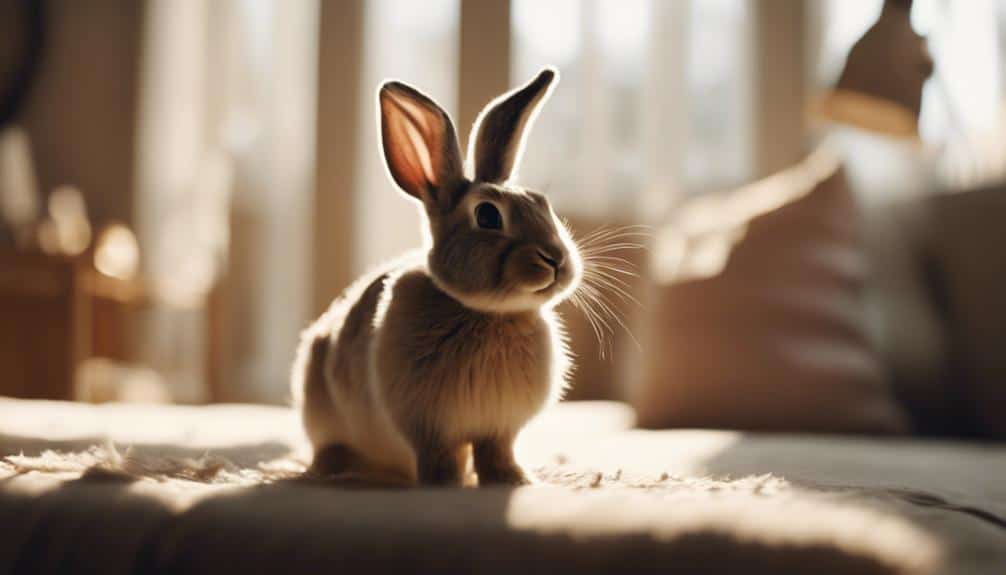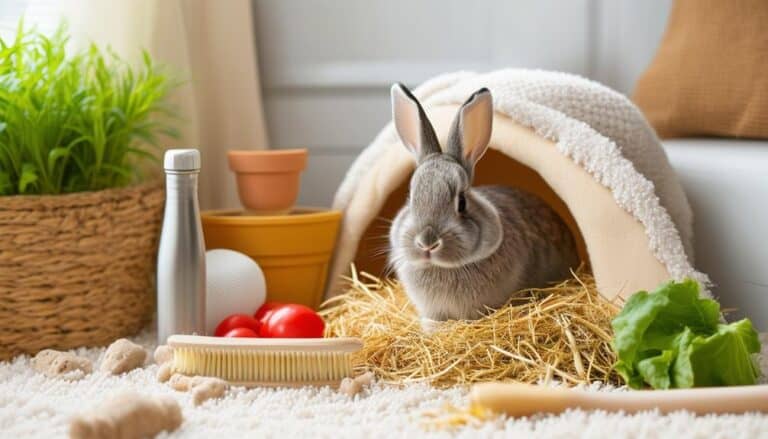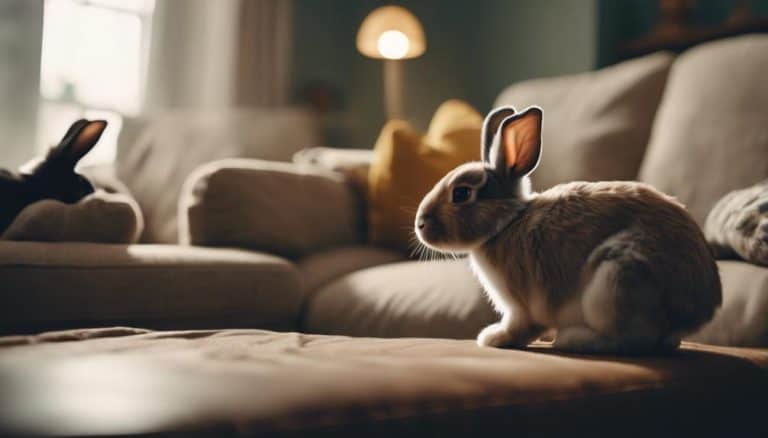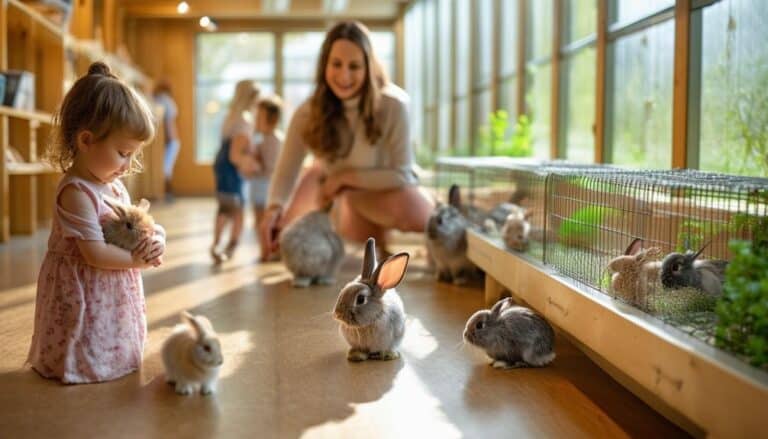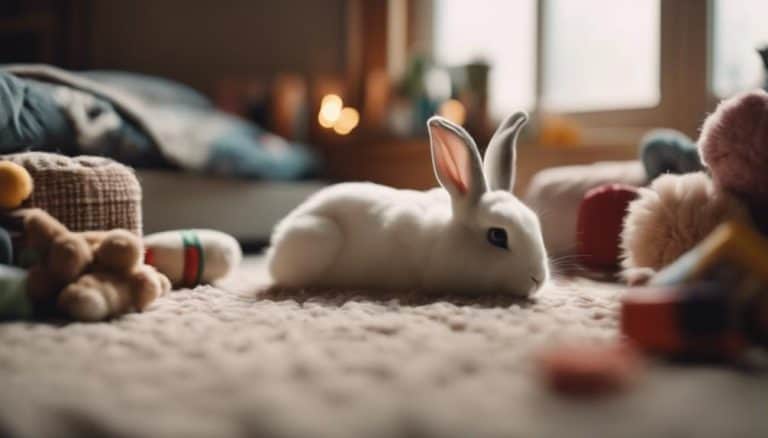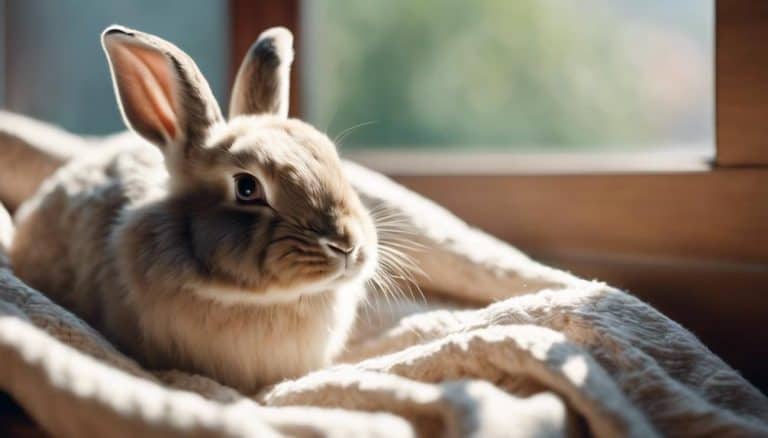Understanding Pet Rabbit Zoomies: A Guide to Hyper Moments
You’ve likely noticed your pet rabbit darting around the room with bursts of energy, often during the early morning or late evening. These hyper moments, known as zoomies, are more than just random spurts of activity. They can tell you a lot about your rabbit’s mood, health, and environment. But what exactly triggers these energetic displays, and how can you guarantee they’re a sign of happiness rather than stress? Let’s explore the various factors that influence this behavior and learn how you can create an ideal space for your rabbit’s well-being.
Time of Day
Rabbits, being crepuscular animals, exhibit heightened activity levels, including zoomies, primarily during dawn and dusk. These twilight hours mark the time of day when your pet is naturally wired to be most active. Studies indicate that rabbits’ circadian rhythms lead to energy peaks during these periods, making them prime times for observable hyper moments.
As a rabbit owner, you’ll likely witness an increase in zoomies behavior in the early morning and late evening. This isn’t coincidental but rather a manifestation of their innate biological clock. During these hours, your rabbit engages in bursts of energetic behavior, darting around with exuberance.
This activity aligns with their evolutionary traits, where heightened alertness during dawn and dusk provided advantages for foraging and avoiding predators. Clinical observations confirm that such hyperactivity during these specific times isn’t a cause for concern but a natural part of their daily cycle.
Monitoring your rabbit’s behavior during these key times of day can provide insights into their overall well-being and happiness. By understanding this pattern, you can better cater to their needs and create an environment that supports their natural tendencies.
Feeling Safe
Ensuring your rabbit feels safe is essential for minimizing stress-induced behaviors like zoomies. You should create a secure environment with ample hiding spots, such as tunnels and boxes, to help your rabbit recognize safe spaces.
Additionally, reducing stress factors by placing the enclosure in a quiet, stable area and incorporating familiar scents and sounds will promote a sense of security.
Secure Environment Importance
Creating a secure environment is crucial to fostering the playful and energetic behaviors known as zoomies in pet rabbits. When rabbits feel secure, their energy levels naturally increase, leading to these bursts of spirited activity. Evidence indicates that a stable and predictable setting greatly enhances a rabbit’s sense of safety. This secure environment directly contributes to their overall well-being and propensity for exhibiting zoomies.
To establish this secure environment, consider minimizing abrupt changes in your rabbit’s living space. While occasional rearrangements can stimulate and excite your rabbit, providing consistent and familiar surroundings helps maintain their comfort levels. According to research, cooler temperatures also play a role in increasing a rabbit’s activity levels, making it more likely for them to engage in zoomies. Ensure your rabbit’s area is both safe and comfortably regulated in temperature.
Furthermore, a secure environment encompasses more than just physical safety; it includes emotional security as well. Rabbits thrive in spaces where they feel protected from potential threats. A well-constructed, secure habitat encourages your rabbit to explore, play, and engage in healthy behaviors like zoomies, ultimately leading to a happier, more active pet.
Recognizing Safe Spaces
Recognizing the subtle cues of your rabbit’s comfort can help you identify and establish safe spaces where they feel secure enough to exhibit zoomies. When your rabbit feels safe, you’ll notice relaxed body language, such as a stretched-out posture or gentle grooming. These behaviors indicate that the environment is perceived as non-threatening, encouraging your rabbit to engage in playful zoomies.
Creating these safe spaces is vital for their well-being. Make sure the area is free from loud noises, sudden movements, and other stressors. Observe your rabbit’s preferences for specific spots they frequent, and provide ample hiding spaces, as this can greatly enhance their feeling of security. These measures will not only promote zoomies but also contribute to their overall happiness and confidence.
By focusing on safe spaces, you enable your rabbit to exhibit their natural, energetic behavior, which is a sign of a healthy and content companion. The table below summarizes key indicators of a safe space and corresponding rabbit behaviors:
| Indicator | Rabbit Behavior |
|---|---|
| Quiet environment | Relaxed posture, grooming |
| Familiar territory | Frequent visits, exploratory behavior |
| Availability of hiding spots | Energetic zoomies, increased activity |
Ensuring these conditions are met boosts your rabbit’s likelihood of engaging in joyful zoomies.
Reducing Stress Factors
To reduce stress in your rabbit, focus on providing a secure and spacious environment that includes plenty of hiding spots and tunnels for retreat. Rabbits are prey animals, and their sense of safety is paramount. By creating an environment with enclosed areas, you can greatly lessen stress factors. These spaces should include comfortable, clean living quarters with access to fresh hay and water, which promote a sense of safety and well-being.
Implementing a consistent routine is another key factor in reducing stress. Rabbits thrive on predictability, and minimizing loud noises and sudden changes can help them feel more secure. Evidence suggests that a stable environment and routine can lower stress levels and encourage calm behavior.
Positive reinforcement training is another effective strategy. By using rewards and gentle encouragement, you’re building trust with your rabbit, which further diminishes stress factors. Positive interactions can make your rabbit feel more secure and less anxious.
Craving Treats
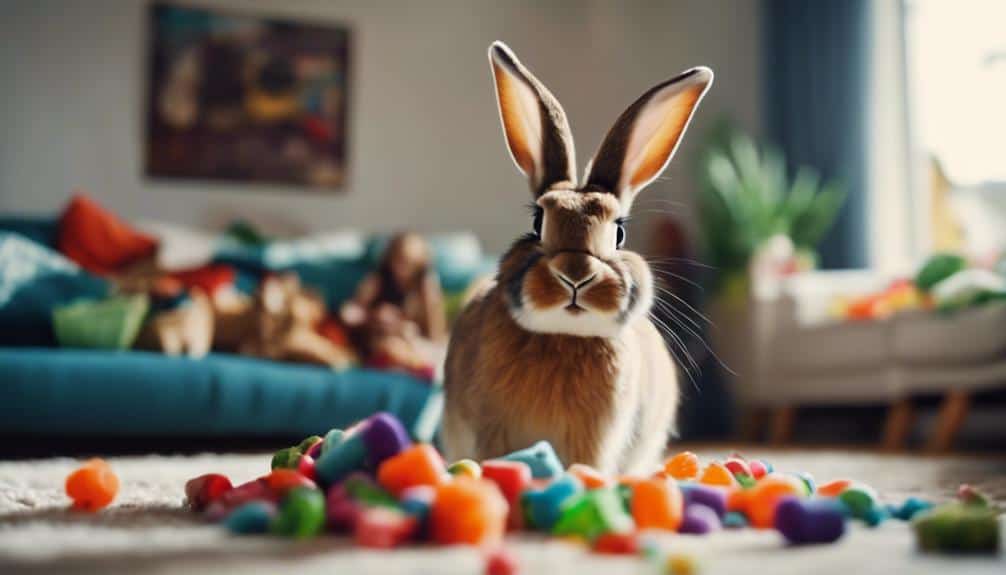
When rabbits crave treats, they often exhibit heightened energy levels, manifesting as hyperactivity linked to the anticipation of their favorite rewards. This treat-related hyperactivity is common, especially when your rabbit associates specific sounds or actions with getting a treat. The moment you pick up the treat bag or rustle some packaging, you may notice your rabbit’s energy surge.
It’s not uncommon for rabbits to perform zoomies or binkies in these moments, showcasing their excitement and anticipation. Providing treats in moderation can help you manage these hyper moments and prevent overexcitement. Excessive treat-giving can lead to an imbalance in their diet, so it’s essential to be mindful of quantities.
Strategically using treats can be an effective tool for training and bonding. Channeling their hyper energy into positive behaviors through treat-based rewards allows you to reinforce good habits and strengthen your relationship.
Observing your rabbit’s behavior when they’re craving treats provides valuable insights into their emotional state and helps you tailor interactions to keep them happy and healthy.
Cooler Weather
In cooler weather, you’ll notice your rabbit’s energy levels increase a lot, leading to more frequent zoomies and playful behavior.
Evidence suggests that rabbits are more active in lower temperatures, particularly during the morning and evening.
To promote this natural behavior, make sure their environment is comfortable and safe.
Increased Energy Levels
Cooler temperatures often lead to a significant increase in your pet rabbit’s energy levels, resulting in frequent zoomies. This phenomenon is rooted in the rabbit’s physiological response to a drop in ambient temperature. Cooler weather can stimulate your rabbit’s metabolism, causing a surge in energy that manifests as heightened activity, commonly referred to as zoomies.
During these hyper moments, your rabbit engages in rapid, spontaneous bursts of movement, which are both a natural and healthy expression of their exuberance. Evidence suggests that these zoomies are a way for rabbits to regulate their body temperature and expend excess energy accumulated from improved metabolic efficiency in cooler conditions.
Moreover, cooler temperatures can trigger an instinctive drive for more activity, reflecting behaviors seen in wild rabbits who are more active during cooler periods to avoid predators and forage. As a result, your pet rabbit may exhibit increased playfulness and a desire to explore its environment more vigorously.
To support these energetic episodes, ensure your rabbit has a safe and spacious area to zoom around. This environment will enable your rabbit to fully engage in these instinctual behaviors while keeping them safe and stimulated.
Comfort and Play
Providing a comfortable and playful environment during cooler weather greatly enhances your rabbit’s quality of life. Cooler temperatures naturally make rabbits feel more comfortable and energetic, leading to frequent zoomie sessions. These bursts of energy aren’t only entertaining but also beneficial for your rabbit’s physical and mental health.
To optimize your rabbit’s environment during cooler weather, consider these evidence-based strategies:
- Safe Play Area: Make sure your rabbit has a secure and spacious area where they can run and jump freely. This could be an indoor pen or a rabbit-proofed room.
- Interactive Toys: Offer a variety of toys that stimulate your rabbit’s curiosity and keep them engaged. Puzzle feeders, tunnels, and chew toys are excellent choices.
- Comfortable Bedding: Use soft, insulating bedding materials to keep your rabbit warm and cozy. This creates a safe haven for rest after their energetic zoomie sessions.
Cool weather not only boosts your rabbit’s comfort but also promotes a more playful and active demeanor. Observing your rabbit enjoy their zoomies in a well-prepared environment can be a delightful experience. By following these tips, you’re ensuring a happy and healthy life for your furry companion.
Youthful Energy
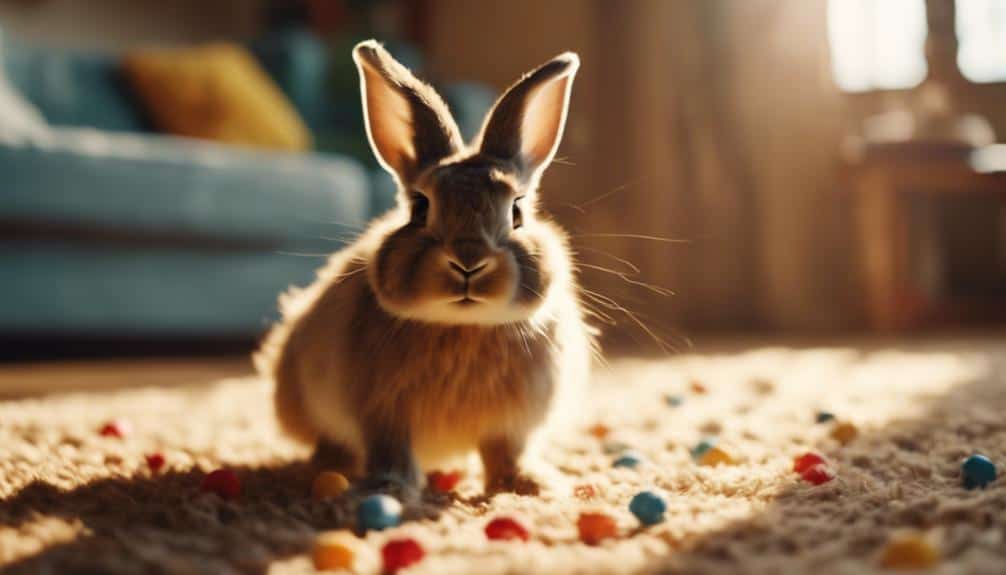
Youthful energy in rabbits manifests as frequent, high-spirited zoomies, driven by their innate need to expend surplus energy. Young rabbits, in particular, are known for their playful and hyperactive behavior. They exhibit zoomies as a natural expression of excitement and joy. This hyperactivity isn’t just essential—it’s a fundamental component of their physical and mental well-being.
Providing appropriate outlets for this energy is essential. Ensuring your young rabbit has enough space to run, jump, and play helps prevent behavioral issues and keeps them healthy. You’ll notice that their energetic nature contributes to frequent bouts of zoomies, especially during morning and evening hours.
Here’s a breakdown of what to expect:
| Age Group | Energy Level | Common Behaviors |
|---|---|---|
| Young Rabbits | High | Zoomies, binkies, playful hops |
| Adult Rabbits | Moderate | Regular activity, less frequent zoomies |
| Senior Rabbits | Low to Moderate | Gentle movements, less active |
Understanding the youthful energy of young rabbits equips you to create an environment that supports their natural inclinations. By fostering a space where they can freely express their high-spirited zoomies, you’re contributing to their overall happiness and well-being. Remember, a happy rabbit is a healthy rabbit!
Hormonal Changes
Hormonal changes in young rabbits can greatly influence their behavior and energy levels, often leading to increased hyperactivity and restlessness. As they enter adolescence, you might observe behaviors such as charging and mounting objects. These actions are typical manifestations of hormonal fluctuations during this developmental stage.
To manage these behaviors effectively, consider the following steps:
- Spaying/Neutering: This can substantially reduce hormonal behaviors like aggression and hyperactivity, creating a more balanced and calm environment for your rabbit.
- Monitoring: Keep a close eye on sudden changes in behavior to differentiate between normal hormonal activity and potential health issues.
- Environment: Maintain a stimulating environment that allows your rabbit to expend its energy in healthy ways.
Evidence indicates that hormonal changes can significantly impact your rabbit’s energy levels and overall behavior. Addressing these changes through clinical interventions, such as spaying or neutering, can’t only mitigate hyperactivity but also promote long-term well-being.
Boredom and Loneliness
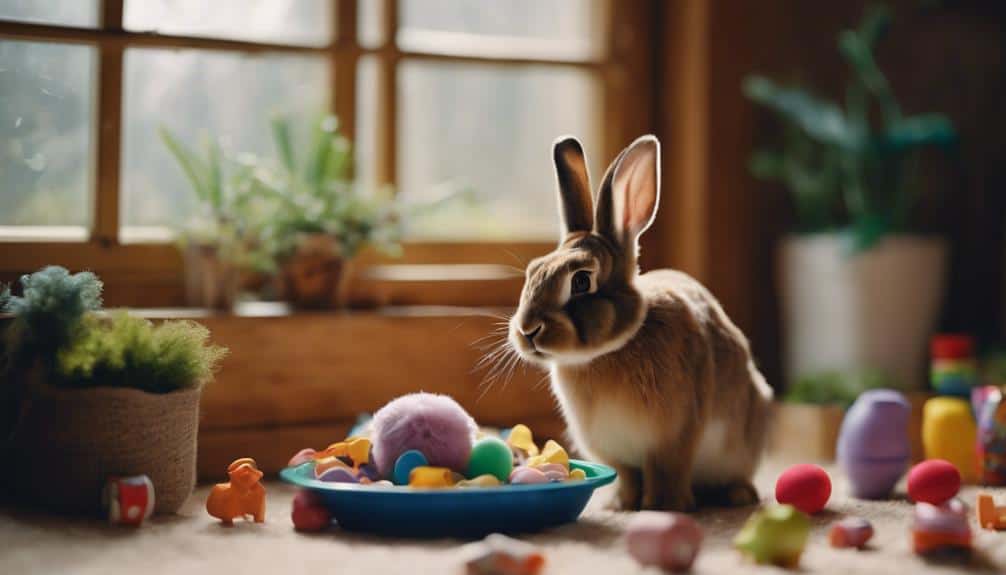
While hormonal changes can greatly influence your rabbit’s behavior, addressing boredom and loneliness is equally crucial in managing hyperactivity and zoomies.
Rabbits are highly intelligent, social creatures that crave mental and physical stimulation. When deprived of these, they may exhibit hyperactive behaviors, such as frantically running around or being excessively vocal, as a means to seek engagement or express distress.
To mitigate boredom, provide your rabbit with a variety of toys and puzzles. These items can keep them mentally stimulated and physically active, reducing the likelihood of hyperactive outbursts. Enrich their environment with tunnels, hiding spots, and chew toys to offer further stimulation and prevent loneliness.
Social interaction is essential. Regular companionship with either humans or other rabbits can alleviate feelings of isolation. If your rabbit is alone for extended periods, consider adopting another rabbit to provide companionship.
Interactive playtime is also crucial. Spend time each day engaging with your rabbit through activities that challenge their mind and body.
Unique Personality
Understanding your rabbit’s unique personality is essential for effectively managing and appreciating their zoomies behavior. Each rabbit exhibits a distinct set of traits that can greatly influence their propensity for hyperactivity. Recognizing these individual differences helps you tailor your approach to their care, ensuring a more harmonious and enjoyable relationship.
Rabbits with a playful and energetic nature often display more frequent zoomies. Factors such as age, breed, and past experiences play important roles in shaping your rabbit’s personality and their tendency for these lively moments. Younger rabbits, for instance, usually have more energy and may exhibit more zoomies compared to older, more sedentary ones. Additionally, certain breeds are naturally more active and curious.
To better understand and manage your rabbit’s zoomies, consider the following:
- Observe Behavior Patterns: Note when and how often your rabbit exhibits hyper moments to identify any triggers or patterns.
- Consider Individual Traits: Take into account your rabbit’s age, breed, and history to anticipate their activity levels.
- Create an Enriching Environment: Provide toys and space that cater to your rabbit’s unique personality, encouraging healthy expression of their energy.
Conclusion
When understanding your rabbit’s zoomies, it’s essential to take into account their circadian rhythms, need for security, and environmental stimuli. By providing a stimulating and safe environment, you’ll mitigate stress-induced behaviors and promote natural, healthy activity.
Address hormonal changes and boredom with appropriate enrichment and social interaction. Recognize that each rabbit’s unique personality influences their energetic outbursts.
With these evidence-based strategies, you can foster a content, active companion, enhancing both their well-being and your bond.

